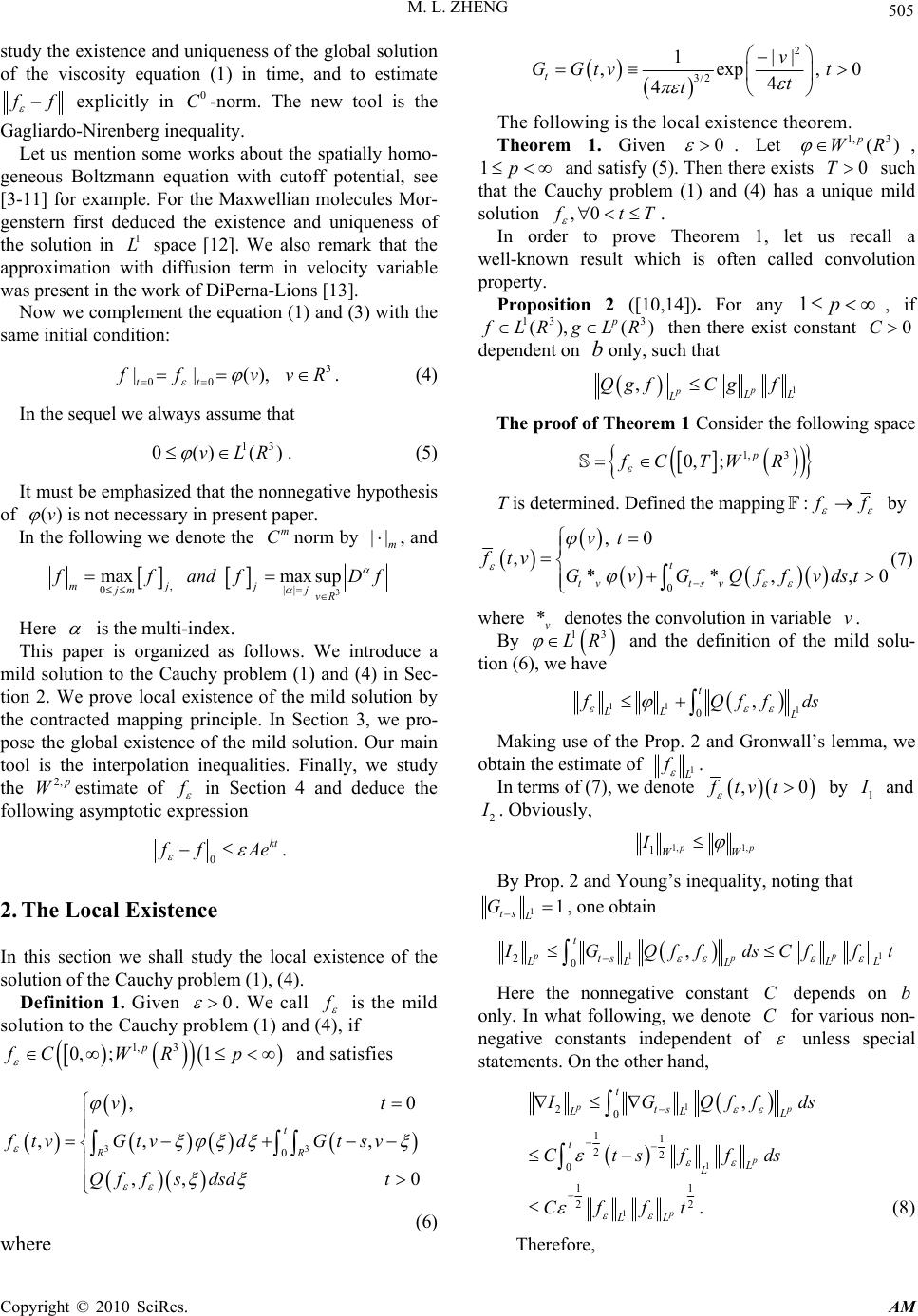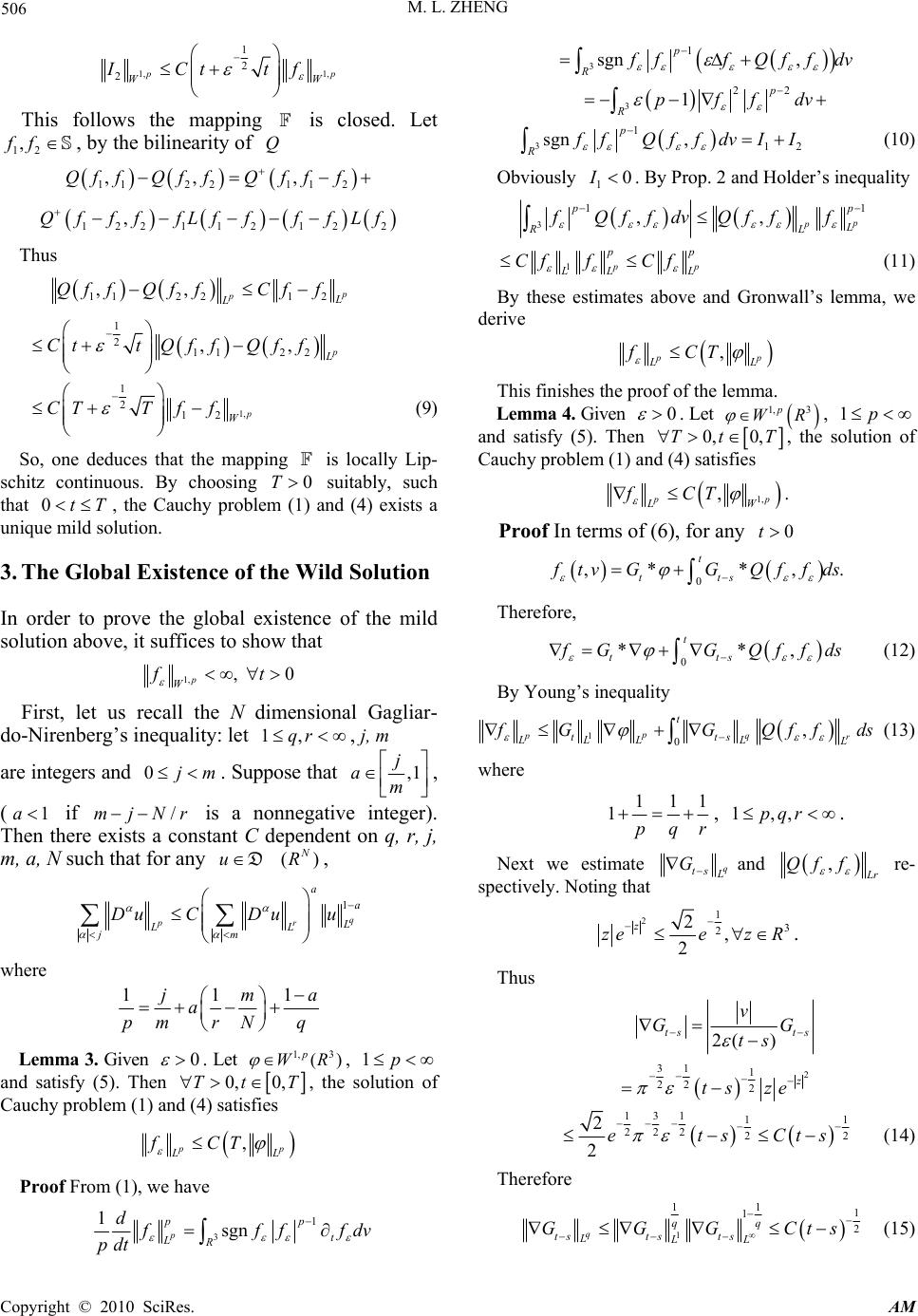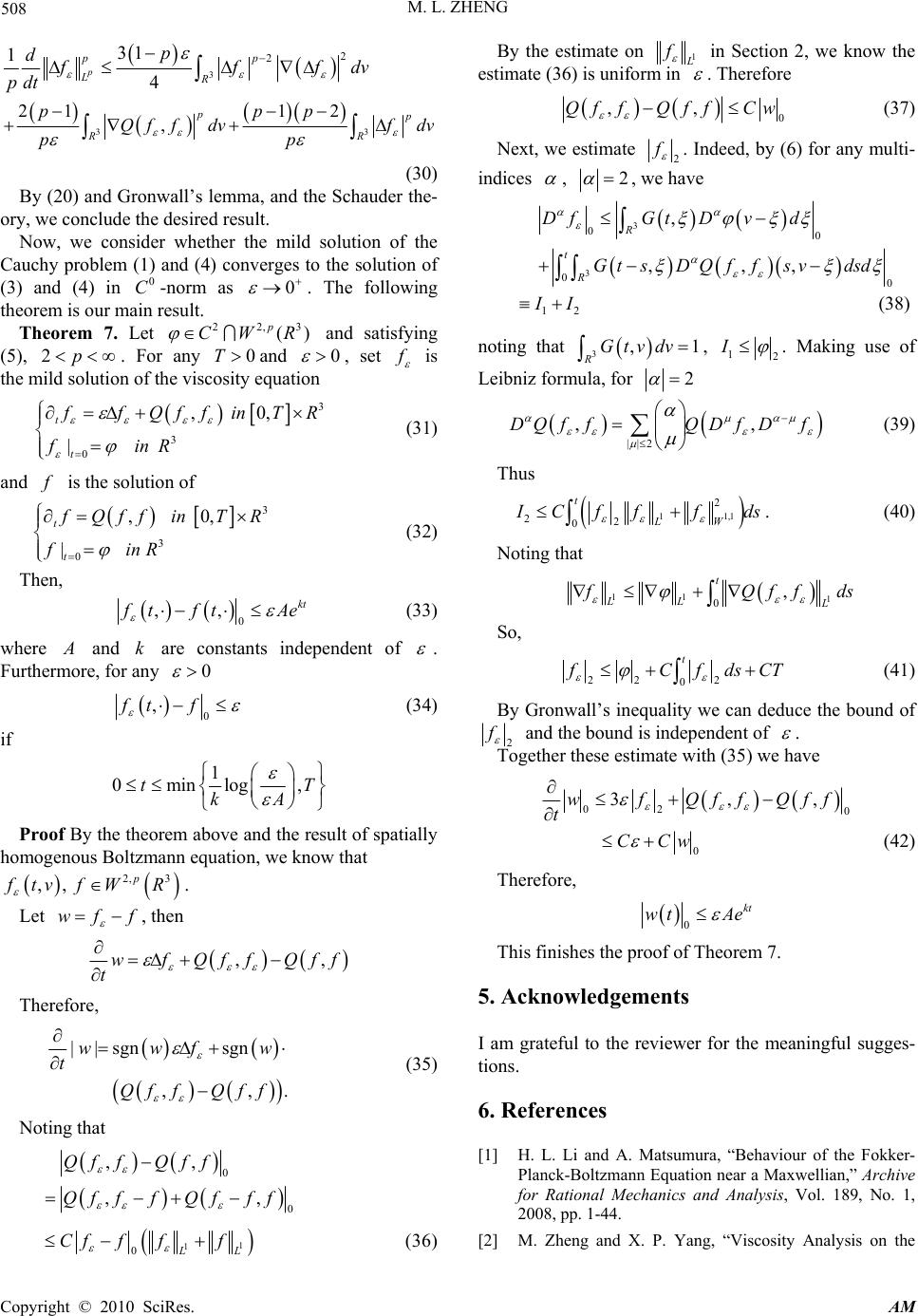Paper Menu >>
Journal Menu >>
 Applied Mathematics, 2010, 1, 504-509 doi:10.4236/am.2010.16066 Published Online December 2010 (http://www.SciRP.org/journal/am) Copyright © 2010 SciRes. AM C 0Approximation on the Spatially Homogeneous Boltzmann Equation for Maxwellian Molecules* Minling Zheng School of Science, Huzhou Teacher College, Huzhou, China E-mail: mlzheng@yahoo.com.cn Received August 25, 2010; revised October 15, 2010; accepted October 19, 2010 Abstract In this paper we study the viscosity analysis of the spatially homogeneous Boltzmann equation for Maxwel- lian molecules. We first show that the global existence in time of the mild solution of the viscosity equation (,) tv f Qf ff . We then study the asymptotic behaviour of the mild solution as the coefficients 0 , and an estimate on 0 f f is derived. Keywords: Viscosity Boltzmann Equation, Mild Solution, Viscosity Approximation, Collision Kernel 1. Introduction In this paper we shall investigate the asymptotic properties of the solution of the viscosity Boltzmann equation for Maxwellian molecules , tv f Qf ff in 3 0, R (1) as the viscosity coefficients 0 . Here, (,)Qf f is the Boltzmann collision operator for Maxwellian molecules defined by its quadratic form 3** 0 * ,2 cos sin R Qfgfg fg bddv where function b is nonnegative and continuous, and 1 cos sin0,bL . Here the shorthand ,' f ftv , ** , f ftv are used; * ',vv are the post-collisional velocities corresponding to the pre-collisional velocities * ,vv respectively, which submit to the elastic collision law * ** ', ', vvvv vvvv (2) where (,) denotes the scalar product. 2 S the 2-D unit sphere and (')/|'|vv vv . is the angle between * vv and , 0, . On physically, Q satisfies the symmetrization and translation invariance. For Maxwellian potential Q can be split into Q and _ Q: ,,,QffQ ffQ ff 32 ** ,cos RS Qffffb ddv 32 ** ,, cos RS Qff fLf Lffb ddv The problem of viscosity approximation of the spa- tially homogeneous Boltzmann equation, namely wheth- er the solution of (1) converges to the solution of the equation , t f Qff in 3 0, R (3) as 0 , is very interested for mathematical theory of Boltzmann equation as well as practical applications. We know that the energy of the solution of (1) is increasing with the time t due to the diffusion effect. We cannot expect that the so lu tion o f (1) approaches to the Maxwel- lian equilibrium in large time. This observation has re- cently been shown by Li-Matsumura [1]. In early work of the authors an explicit estimate of f f in 1 k L was derived which indicates also the dependence of time [2]. It must be stressed this result excludes the case of Maxwellian molecules. Actually, the produce of mo- ments for cutoff potential is not valid for Maxwellian molecules. In this paper we shall study the viscosity ap- proximation for Maxwellian molecules. Our goal is to *This work was supported by Huzhou Natural Science Foundation (2008YZ06) and Innovation Team Foundation of Department of Educa- tion of Zhe j ian g Province ( T200924 ) .  M. L. ZHENG Copyright © 2010 SciRes. AM 505 study the existence and uniqueness of the global solution of the viscosity equation (1) in time, and to estimate f f explicitly in 0 C-norm. The new tool is the Gagliardo-Nirenberg inequality. Let us mention some works about the spatially homo- geneous Boltzmann equation with cutoff potential, see [3-11] for example. For the Maxwellian molecules Mor- genstern first deduced the existence and uniqueness of the solution in 1 L space [12]. We also remark that the approximation with diffusion term in velocity variable was present in the work of DiPerna-Lions [13]. Now we complement the equation (1) and (3 ) with the same initial condition: 3 00 ||(), tt f fvvR . (4) In the sequel we always assume that 13 0() ()vLR . (5) It must be emphasized that the nonnegative hypothesis of ()v is not necessary in present paper. In the following we denote the m Cnorm by || m , and 3 , 0|| max maxsup mjj jm jvR f fandf Df Here is the multi-index. This paper is organized as follows. We introduce a mild solution to the Cauchy problem (1) and (4) in Sec- tion 2. We prove local existence of the mild solution by the contracted mapping principle. In Section 3, we pro- pose the global existence of the mild solution. Our main tool is the interpolation inequalities. Finally, we study the 2, p Westimate of f in Section 4 and deduce the following asymptotic expression 0 kt f fAe . 2. The Local Existence In this section we shall study the local existence of the solution of the C auchy problem (1), (4). Definition 1. Given 0 . We call f is the mild solution to the Cauchy problem (1) and (4), if 1, 3 0, ;1 p fCWRp and satisfies 33 0 ,0 ,, , ,, 0 t RR vt ftvGtvdGtsv Qf fsdsdt (6) where 2 3/2 1|| ,exp,0 4 4 tv GGtv t t t The following is the local existence theorem. Theorem 1. Given 0 . Let 1, 3 () p WR , 1p and satisfy (5). Then there exists 0T such that the Cauchy problem (1) and (4) has a unique mild solution ,0 f tT . In order to prove Theorem 1, let us recall a well-known result which is often called convolution property. Proposition 2 ([10,14]). For any 1p, if 13 3 (), () p f LRgL R then there exist constant 0C dependent on bonly, such that 1 ,p p L L L QgfCg f The proof of Theorem 1 Consider the following space 1, 3 0, ;p fCTW R T is determined. Defined the mapping: f f by 0 ,0 ,**,,0 t tv tsv vt ftvGvGQffvdst (7) where *v denotes the convolution in variable v. By 13 LR and the definition of the mild solu- tion (6), we have 1 11 0, t L LL f Qf fds Making use of the Prop. 2 and Gronwall’s lemma, we obtain the estimate of 1 L f . In terms of (7), we denote ,0ftvt by 1 I and 2 I . Obviously, 1, 1, 1 p p WW I By Prop. 2 and Young’s inequality, noting that 11 tsL G , one obtain 11 20, pp p t ts LL LL L I GQffdsCfft Here the nonnegative constant C depends on b only. In what following, we denote C for various non- negative constants independent of unless special statements. On the other hand, 1 20, pp t ts LL L I GQffds 1 11 22 0p t L L Ctsffds 1 11 22 p LL Cfft . (8) Therefore,  M. L. ZHENG Copyright © 2010 SciRes. AM 506 1, 1, 1 2 2p p WW ICttf This follows the mapping is closed. Let 12 ,ff, by the bilinearity of Q 112 2112 ,, ,Qf fQffQf ff 1221 12122 ,Qfff fLffffLf Thus 112 212 ,, p p L L Qf fQffCff 1 2112 2 ,, p L Ctt QffQf f 1, 1 212 p W CTTff (9) So, one deduces that the mapping is locally Lip- schitz continuous. By choosing 0T suitably, such that 0tT , the Cauchy problem (1) and (4) exists a unique mild solution. 3. The Global Existence of the Wild Solution In order to prove the global existence of the mild solution above, it suffices to show that 1, ,0 p W ft First, let us recall the N dimensional Gagliar- do-Nirenberg’s inequality: let 1,qr, j, m are integer s and 0jm . Suppose that ,1 j am , (1a if /mjNr is a nonnegative integer). Then there exists a constant C dependent on q, r, j, m, a, N such that for any u D () N R, 1 q pr a a L LL jm Du CDuu where 111jma a pm rNq Lemma 3. Given 0 . Let 1, 3 () p WR , 1p and satisfy (5). Then 0, 0,Tt T , the solution of Cauchy problem (1) and ( 4) satisfies ,p pLL fCT Proof From (1), we have 3 1 1sgn p pp t LR d f ff fdv pdt 3 1 sgn , p R f ffQffdv 3 22 1p Rpffdv 3 1 12 sgn , p R f fQffdvII (10) Obviously 10I . By Prop. 2 and Holder’s inequality 3 11 ,, p p p p L L RfQffdvQff f 1 p p p p L LL Cf fCf (11) By these estimates above and Gronwall’s lemma, we derive ,p pLL fCT This finishes the proof of the lemma. Lemma 4. Given 0 . Let 1, 3p WR , 1p and satisfy (5). Then 0, 0,Tt T , the solution of Cauchy problem (1) and ( 4) satisfies 1, ,pp WL fCT . Proof In terms of (6), for any 0t 0 ,* *,. t tts f tvGGQ ffds Therefore, 0 **, t tts f GGQffds (12) By Young’s inequality 10, p pq r t tts LLLL L f GGQffds (13) where 111 1pqr , 1,,pqr. Next we estimate q ts L G and , L r Qf f re- spectively. Noting that 213 2 2, 2 z zeez R . Thus 2( ) ts ts v GG ts 2 31 1 22 2 z ts ze 13111 22222 2 2etsCts (14) Therefore 1 11 1 12 qqq tsts ts LLL GGGCts (15)  M. L. ZHENG Copyright © 2010 SciRes. AM 507 By Gagliardo-Nirenberg’s inequality, ,, , rp p a LL L QffQf fQf f 1 , p a L Qf f (16) where 1111 ,0 1 3 a aa rp p By the translation invariance of Q, it is easily to show that ,,,Qf fQf fQff So making us of Prop. 2 again 11 ,. pp pLLL L L Qf fCffff (17) By (12), it gives 1 1111 0, t tts LLLLL f GGQffds 11 0 t LL Cfds (18) that is 1 1,LL fCT (19) Plugging (19 ) i nt o ( 17 ), gi ves ,pp pLL L Qf fCff . (20) By (20) and (16), 1 , p pp r aa L LL L Qf fCfff 1 p pp aaa L LL Cfff (21) Combining (15), (21) and (13), we deduce 11 2 0 p pppp taaa LLLLL f Ctsfffds (22) According to the Lemma 3, one has 11 22 00 . p p p tt a L LL f Cts dsCtsfds (23) By Gronwall type inequality we obtain the desired re- sult. Next using the basic theory of parabolic equation and the a priori estimate above, we have the following theo- rem. Theorem 5. Gi ven 0 . Let 1, 3p WR , 1p and satisfy (5). Then for any 0T the Cauchy problem (1) and (4) exists a unique mild solution f such that 1, 33 0, ;0, p f CTWR CTR 4. 2, p W Estimate and 0 C Approximation In this section we shall make 2, p Westimate on f and deduce the explicit estimate on the viscosity approxima- tion. Theorem 6. Given 0 , 2p . Then for any 2, 3p WR satisfying (5) the mild solution f of the Cauchy problem (1) and (4) belongs to 2,3 0, ;p CWR. Proof By the equation of (1), one has , f fQff t . (24) Thus 3 1 1sgn p pp t LR d f ff fdv pdt 3 1 sgn , p R f ffQffdv 12 I I (25) Next we estimate 1 I and 2 I respectively. 3 1 1sgn p R I ff fdv 3 2 2 1p Rpf fdv (26) and 3 1 2sgn , p R I ff Qffdv 3 2 1, p Rpf fQffdv 3 22 22 1, pp Rpf fQfffdv (27) By Young’s inequality, for any 0 , 3 2 2 21p R I pf fdv 3 22 1, 4 p R pQf ffdv (28) Employing Young’s inequality again, the second term of the above formulation can be estimated by 33 12 1, 24 pp RR pp pQf fdvfdv pp (29) Taking 4 , and plugging (28), (29) and (26) into (25), it gives  M. L. ZHENG Copyright © 2010 SciRes. AM 508 3 2 2 31 1 4 p pp LR p d f ffdv pdt 33 211 2 ,pp RR ppp Qf fdvfdv pp (30) By (20) and Gr onwall’s lemma, and the Schauder the- ory, we conclude the desired result. Now, we consider whether the mild solution of the Cauchy problem (1) and (4) converges to the solution of (3) and (4) in 0 C-norm as 0 . The following theorem is our main result. Theorem 7. Let 22,3 () p CWR and satisfying (5), 2p. For any 0Tand 0 , set f is the mild solution of the viscosity equation 3 3 0 ,0, | t t f fQffinTR finR (31) and f is the solution of 3 3 0 ,0, | t t f QffinT R finR (32) Then, 0 ,, kt f tft Ae (33) where A and k are constants independent of . Furthermore, for any 0 0 ,ft f (34) if 1 0minlog ,tT kA Proof By the theorem abov e and the result of spatially homogenous Boltzmann equation, we know that 2, 3 ,, p ftvfWR . Let wf f , then ,,wfQffQff t Therefore, ||sgn sgn ,,. wwf w t Qf fQff (35) Noting that 0 ,,Qf fQff 0 ,,Qff fQf ff 1 1 0LL Cf fff (36) By the estimate on 1 L f in Section 2, we know the estimate (36) is uniform in . Therefore 0 ,,Qf fQffCw (37) Next, we estimate 2 f . Indeed, by (6) for any multi- indices , 2 , we have 3 00 , R DfGt Dvd 3 00 ,,, t RGtsDQ ffsvdsd 12 I I (38) noting that 3,1 RGtvdv , 12 I . Making use of Leibniz form ul a, for 2 ||2 ,,DQ ffQD fDf (39) Thus 11,1 2 22 0 t LW I Cfffds . (40) Noting that 1 11 0, t L LL fQffds So, 2 22 0 t f CfdsCT (41) By Gronwall’s inequality we can deduce the bound of 2 f and the bound is independent of . Together these estimate with (35) we have 020 3,,wfQffQff t 0 CCw (42) Therefore, 0 kt wt Ae This finishes the pr o of o f T h eor em 7. 5. Acknowledgements I am grateful to the reviewer for the meaningful sugges- tions. 6. References [1] H. L. Li and A. Matsumura, “Behaviour of the Fokker- Planck-Boltzmann Equation near a Maxwellian,” Archive for Rational Mechanics and Analysis, Vol. 189, No. 1, 2008, pp. 1-44. [2] M. Zheng and X. P. Yang, “Viscosity Analysis on the  M. L. ZHENG Copyright © 2010 SciRes. AM 509 Spatially Homogeneous Botzmann Equation,” Asymptotic Analysis, Vol. 53, 2007, pp. 13-28. [3] L. Arkeryd, “On the Boltzmann Equation,” Archive for Rational Mechanics and Analysis, Vol. 45, 1972, pp. 1-34. [4] L. Arkeryd, “Stability in L1 for the Spatially Homogene- ous Boltzmann Equation,” Archive for Rational Mechan- ics and Analysis, Vol. 103, 1988, pp. 151-167. [5] T. Elmroth, “Global Boundedness of Moments of Solu- tion of the Boltzmann Equation for Forces of Infinite Range,” Archive for Rational Mechanics and Analysis, Vol. 82, 1983, pp. 1-12. [6] L. Desvillettes, “Some Applications of the Method of Moments for the Homogeneous Boltzmann Equation and Kac Equation,” Archive for Rational Mechanics and Analysis, Vol. 123, 1993, pp. 387-395. [7] S. Mischler and B. Wennberg, “On the Spatially Homo- geneous Boltzmann Equaion,” Annales de l’Institut Henri Poincar´e - Analyse non lin´eaire, Vol. 16, No. 4, 1999, pp. 467-501. [8] B. Wennberg, “Entropy Dissipation and Moment Prod- uction for the Boltzmann Equation,” Journal of Statistical Physics, Vol. 86, 1997, pp. 1053-1066. [9] B. Wennberg, “Stability and Exponential Convergence in Lp for the Spatially Homogeneous Boltzmann Equation,” Nonlinear Analysis, Theory, Methods & Applications, Vol. 20, 1993, pp. 935-964. [10] C. Mouhot and C. Villani, “Regularity Theory for the Spatially Homogeneous Boltzmann Equation with Cut- off,” Archive for Rational Mechanics and Analysis, Vol. 173, No. 2, 2004, pp. 169-212. [11] C. Mouhot, “Rate of Convergence to Equalibrium for the Spatially Homogeneous Boltzmann Equation with Hard Potentials,” Communications in Mathematical Physics, Vol. 261, 2006, pp. 629-672. [12] D. Morgenstern, “General Existence and Uniqueness Proof for Spatial Homogeneous Solution of the Maxwell- Boltzm-ann Equation in the Case of Maxwellian Mole- cules,” Proceedings of the National Academy of Sciences, Vol. 40, 1954, pp. 719-721. [13] R. J. DiPerna and P. L. Lions, “On the Fokker-Planck- Boltzmann Equation,” Communications in Mathematical Physics, Vol. 120, No. 1, 1988, pp. 1-23. [14] I. M. Gamba, V. Panferno and C. Villani, “On the Boltz- mann Equation for Diffusively Excited Granular Media,” Communications in Mathematical Physics, Vol. 246, No. 3, 2004, pp. 503-541. |

